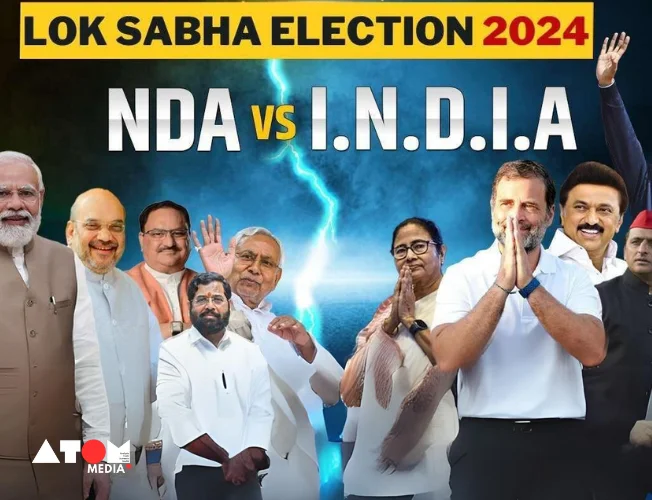Lok Sabha Election Results: BJP Secures 240 Seats, Congress Wins 99
The Election Commission of India has announced the results for 542 of the 543 Lok Sabha constituencies, with the BJP securing 240 seats and the Congress winning 99. Counting was held for 542 seats as BJP’s Surat candidate Mukesh Dalal was elected unopposed. The BJP-led National Democratic Alliance (NDA) has won a majority in the Lok Sabha, allowing Prime Minister Narendra Modi to establish the government for a third consecutive term. Despite substantial losses in three Hindi heartland states, the BJP’s candidates campaigned under Modi’s leadership and won 240 seats. However, this falls short of the required 272 majority, necessitating the cooperation of NDA allies for government formation. This result contrasts sharply with the BJP’s 303 and 282 seats gained in 2019 and 2014, respectively, when it held a majority on its own.
Allies Support NDA to Cross Majority Mark
The NDA’s coalition strength was bolstered by support from key allies. N Chandrababu Naidu’s Telugu Desam Party (TDP) won 16 seats in Andhra Pradesh, while Nitish Kumar’s Janata Dal (United) [JD(U)] secured 12 seats in Bihar. With contributions from other alliance partners, the NDA successfully crossed the halfway mark required to form the government.
Congress and the Opposition INDIA Bloc
The Congress party, a key member of the opposition INDIA group, increased its total to 99 seats from 52 in the 2019 elections. This gain in Congress seats significantly reduced the BJP’s share in states such as Rajasthan and Haryana. In Uttar Pradesh, the Samajwadi Party, which is also part of the INDIA alliance, won 37 seats, keeping opposition morale high in the state. Meanwhile in West Bengal, the Trinamool Congress (TMC) won 29 seats, up from 22 in 2019. The BJP, which earlier won 18 seats in West Bengal, was only able to secure 12 this time.
Awaiting Results for Beed Constituency
The outcome for Maharashtra’s Beed constituency is still expected, with NCP (Sharad Pawar) candidate Bajrang Manohar Sonwane leading against BJP’s Pankaja Munde. The results did not bring the landslide victory that the BJP-led NDA had anticipated for, as predicted by various exit polls. Despite its strong performance, the party fell short of its historical results in the last two Lok Sabha elections.
Massive Voter Turnout
This election saw a tremendous voter turnout, with over 640 million ballots cast in what is considered the world’s largest democratic exercise. The voting took place in seven sessions between April 19 and June 1. The election witnessed a variety of regional dynamics at work. In Andhra Pradesh, the TDP emerged as a powerful force, capturing 16 seats and contributing significantly to the NDA’s overall tally. Bihar saw the JD(U) provide 12 seats, which strengthened the NDA’s advantage. The Samajwadi Party dominated Uttar Pradesh’s political landscape, winning 37 seats and reflecting the state’s complex voter opinion.
Analysis of BJP’s Decline in Key States
The BJP had significant drops in crucial Hindi heartland states, which played a critical part in their overall seat loss. The party’s performance in Rajasthan and Haryana was severely hampered by the Congress’s resurgence, which secured a significant number of seats, reducing the BJP’s control in these states.
Role of Opposition Alliances
The development and deliberate campaigning of the opposition INDIA bloc, which included parties such as Congress, Samajwadi Party, and TMC, played an important role in threatening the BJP’s grip. The parties’ combined efforts resulted in a more balanced seat distribution, reflecting the electorate’s diverse political mandate.
Strategic Alliances and Future Implications
The election results highlight the role of strategic alliances in India’s political environment. The BJP’s reliance on NDA allies demonstrates the changing character of coalition politics in the country. Regional parties and their strategic alliances will continue to influence India’s political future, impacting national governance and policymaking.
Political Landscape Post-Elections
As India progresses, the political scene is expected to experience substantial changes. The BJP’s need to work with its allies in the NDA to create a government represents a departure from the party’s past standalone majority. The comeback of Congress and the performance of regional parties point to a more competitive and dynamic political climate. The 2024 Lok Sabha election results reveal a complex and shifting political scene in India. While the BJP remains the dominant force, the emergence of opposition alliances and regional party performance highlights the complexities of India’s political process. In the coming years, we shall observe how these processes unfold and influence national governance.
Read more: Marketing News, Advertising News, PR and Finance News, Digital News





